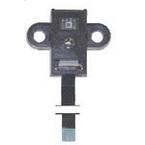The OPB780Z color sensor uses a light-to-frequency converter that combines 64 configurable silicon photodiodes (on a 144 um center and measuring 120 um x 120 um each), with a white LED in a small, lightweight package that makes it ideal for using in miniature applications. The output is a square wave (50% duty cycle) with a frequency directly proportional to reflected light intensity
●(irradiance). The light-to-frequency converter reads an 8 x 8 array of photodiodes that consists of four groups of 16 photodiodes
●each, segregated by color: 16 photodiodes with red filters, 16 photodiodes with green filters, 16 photodiodes with blue filters and 16 clear photodiodes with no filters. Each color"s group of 16 photodiodes is interdigitated to minimize the effect of non-uniformity of the incident irradiance. Each color"s group is also connected in parallel. The type of photodiode used during operation is pin-selectable.
●The output of the device is designed to drive a standard TTL or CMOS logic input over short distances. The internal photodiode used by the device is controlled by two logic inputs, S2 and S3.
●Applications:
● Photographic equipment
● Colormetry
● Chemical analyzers
● Display contrast controls
● High resolution digital measurement of light intensity
●Features:
● High-resolution conversion of light intensity to frequency
● Selectable color output frequency
● Communicates directly with a microcontroller
● Sensor power supply operation (2.7 V to 5.5 V)
● LED power separate input
● Includes LED, Sensor and interface cable


